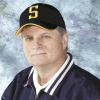This a story with many different puzzle pieces, so if you like taking separate pieces of information and placing them together to form a golf story, you’re in luck.
The first puzzle piece is about a two-sport athlete named Dewey, who excelled in two different arenas and is linked to Babe Ruth and Ben Hogan by way of Jim Ballard.
If you are over 60 years old, you might remember past two-sport athletes such as Gene Conley (Milwaukee Braves pitcher and backup center for the Celtics); Chuck Connors (TV’s Rifleman, Celtics and Brooklyn Dodgers); Bo Jackson (K.C. Royals outfielder and L.A. Raiders running back), and of course Deion Sanders (Atlanta Falcons safety and Atlanta Braves outfielder). But this two-sport athlete changed the course of golf history with a handkerchief.
Puzzle piece number two starts with Dewey’s birth in Bremen, Georgia on October 15, 1906. Shortly thereafter, his parents moved to Birmingham, Alabama, where as a teenager he became a star athlete in high school. At age 23, he signed a professional contract to play for the New York Yankees. Baseball was his first love and first of his two-sport career.
Samuel Dewey “Sammy” Byrd joined the Bronx Bombers in 1929 and played in 62 games. He had a decent rookie year batting .312 with five home runs and 28 RBI. He lasted eight years in the pros, finishing his career with the Cincinnati Reds, but while he was with the Yankees, he earned the nickname “Babe Ruth’s Legs.”
Puzzle piece number three involves being one of Babe Ruth’s closest friends, his road roommate and late innings pinch runner for the Babe in the latter years of Ruth’s career. (Sports writers and teammates nicknamed him Babe Ruth’s legs.)
But little did Sam Byrd know that a hitting tip from one of the greatest baseball players who ever played the game would lead to Ben Hogan and the Golf Hall of Fame.
During a conversation on hitting techniques, Babe Ruth told Byrd the secret to his success was a keen eye and practicing his swing with a handkerchief tucked under his lead arm (right arm, since Ruth batted left-handed). Byrd adapted this technique of “keeping his left arm connected to his body,” since he batted right-handed and finished his Major League career (744 games) with 38 home runs, 220 RBI and a .274 batting average (a millionaire’s stats by today’s standards).
Puzzle piece number four starts in 1936, when Dewey quit baseball to pursue a new career in professional golf. In 1939 he won the Philadelphia Open Championship for his first win as a pro.
From 1942 through 1945 he had six PGA tour wins while finishing third in the Masters in 1941 and fourth in 1942, but his biggest contribution to golf happened many years later in a conversation with Ben Hogan.
Time to bring all the puzzle pieces together and tell you the rest of the story as told by Jim Ballard, who wrote, “How to Perfect Your Golf Swing Using Connection and the Seven Common Denominators.”
At age seventeen, Ballard was the Alabama State Junior Champ and after he retired from professional golf he worked for Byrd on his par-three golf course in Birmingham. During his tenure as a teaching assistant, Ballard learned in conversation with Byrd that a young professional named Ben Hogan was struggling with a “duck hook” and was considering quitting the pro circuit.
When Byrd and Hogan met, Sammy explained the handkerchief drill in great detail. The drill included bracing your right leg on the backswing, keeping the left arm tucked close to the body, slight movement of the head to the right, coiling for power and firing the right side of the body toward the target. Through persistence and practice Hogan put the tip - passed down from Babe Ruth to Byrd to him - into practice. The rest, as they say, is history.
19th Hole Trivia:
Byrd is the only athlete to have played in a World Series game and played golf in the Master’s Tournament.
In 1945, he lost to Byron Nelson in the final round of the PGA Championship.
Byrd’s 1939 U.S. Open 16th place winnings: $66.67.




















































